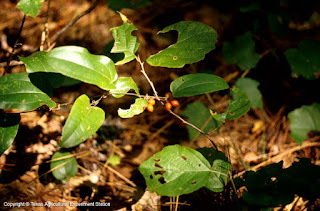You have seen it if you live at Holly Lake Ranch.
That vine with the shiny green leaves, beautiful red or black berries, and
thorns, prickles or spines (depending on species). Like you care if it is a
prickle or thorn when the vine is stuck in the middle of your leg!! We are talking about Smilax or Greenbrier.
 |
| Run-in with Smilax |
If you are curious, a prickle is a sharp outgrowth
from the plant’s bark. A thorn is a modified stem. A spine is a sharp pointed
modified leaf. Even more confusing is all true Greenbriers are Smilax but not
all Smilax species are Greenbriers. Here is east Texas we are “blessed” with
many species of Smilax but suffice it to say, we will call it Smilax.
The red-berried Smilax (Smilax walteri) creeps over bushes at the edges of sandy swamps or
near streams. It is a thin woody vine, which may be spiny or nearly spineless.
Its leaf surfaces are shiny green and it bears red berries during the winter.
It has long underground runners, but is not tuberous.
Sarsaparilla Vine (Smilax pumila) can be found growing in the open sandy woods of east
Texas. This weak, “unarmed” vine has few tendrils at the nodes and prefers to climb over low plants. The young leaves and stem are densely pubescent (having
fine hairs), becoming lustrous and smooth as it ages. It, too, has red berries but in
the spring.
China-root smilax (Smilax tamnoides) likes the damp woods
and low areas near creeks. It has knotty rhizomes, while the vine runs over
bushes and climbs into trees using its tendrils. The lower part of the stem is
covered with needle-like spines. The shiny leaves are of different shapes.
 |
| Tamnoides - photo courtesy of Benny Simpson's Texas Native Shrubs |
There are other species of Smilax: laurifolia, bona nox, routunifolia, smallii, and glauca, lasioneura that grow in Texas. One species is enough for me!
The one redeeming quality of this plant is that parts
are edible. **DO NOT EAT
ANY PLANT UNLESS YOU ARE 100% SURE WHAT THE PLANT IS.** On
Merriwether’s blog "Foraging Texas", he states that tender vines, tendrils, tubers, leaves and
berries are edible. He even makes vegan jello shots from this plant. Here is his blog: http://www.foragingtexas.com/2008/08/greenbriar.html.
You may not want this vine in your garden or yard
and are having trouble getting rid of it. No amount of cutting or spraying will
do the trick. The problem is tubers! Digging out the tubers is the only way to
do away with this leg-eating vine. But if you read Merriwether’s blog, the
tubers are high in starch and edible. Wonder if I can substitute tubers for
potatoes in my diet?
 |
| Tubers from one plant |
 |
| Baby Smilax - photo courtesy of Sonnia Hill |
So, if you are out working in the woods, be sure to
wear leather gloves, long sleeves and jeans. Be sure to tell your family where you are. If you should go missing, they will know you are
being held captive by the thorns, prickles, and spines of Smilax!
And, as always, things could be worse. . . .
And, as always, things could be worse. . . .
 |
Ann
Reynolds


No comments:
Post a Comment